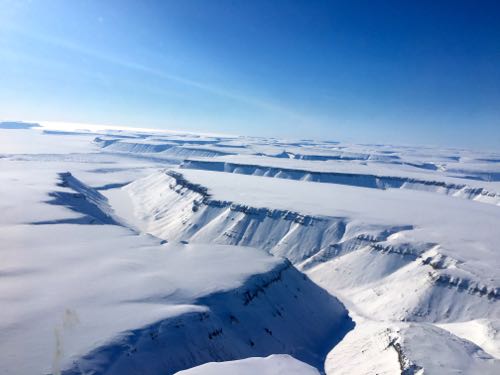 Project IceBridge's P-3 Orion sitting on the tarmac at Kangerlussuaq Airport.
Project IceBridge's P-3 Orion sitting on the tarmac at Kangerlussuaq Airport.
Last night at our normal nightly meeting we were told to make sure we bring our passports. We are supposed to bring our passports with us on every flight in case we have to divert. A plane will divert when it can't land at the intended airport. This does not mean there is a problem with the plane. It could just be that the airport the plane originally had intended to fly to has poor weather conditions so the plane can't land. That is the scenario we might face on our return trip today. We were reminded of our passports because we were going to be flying to Canada. Normally this mission would be flown out of Thule because Thule has the closer airport. The crew chose to do this mission because it was the best option available.
 A flight plan put together by John Sonntag combining two different missions, which focused on Devon Island and Bylot Island off the coast of Canada.
A flight plan put together by John Sonntag combining two different missions, which focused on Devon Island and Bylot Island off the coast of Canada.
Before we take off in the morning the pilots look at the weather for where we are going, and for our return trip, to make sure we can actually return back to Kangerlussuaq. Going from Greenland to Northeast Canada is not a very far flight, but it is not what would normally be planned as a flight out of Kangerlussuaq. Greenland is still a windy and cloudy mess so clearer skies must be sought out for the missions to continue. This is a medium priority mission and it is really two different missions spliced together. This allows Operation IceBridge to collect data on a day when most missions are not feasible. John Sonntag (NASA engineer and scientist) is constantly looking at the weather. He knows all of the 63 flight plans that IceBridge wants to fly. From the beginning of the expedition the crew knows that they will not fly all of the 63 flights. The flights are arranged in priority order. Baseline flights, the highest priorities, are the flights that Operation IceBridge have flown before and/or that show the most change. There are also some baseline flights that are in areas that show little change. These areas are used to show unbiased data collection. John says he looks at the flights like a quiver of arrows. Each one just waiting to be pulled out. This analogy is perfect because in my mind John is a hunter seeking out a flight line that will give the crew the best results. Most times he catches his prey but there are days like yesterday where no missions can be flown. Today, John catches his prey, our flight plan is to combine parts of two missions. John created a new mission calling it Devin-Bylot. Devin and Bylot are both islands in Northeastern Canada.
 The edge of Devyn Icecap.
The edge of Devyn Icecap.
 Mountains on Bylot Island. One can see last year's melt channel.
Mountains on Bylot Island. One can see last year's melt channel.
The flight had a long transit, in other words it took a while to get to our desired location. The flight was just over seven hours there and back and we had about three hours of active data collection. Those three hours were worth it. I was looking at snow covered mountains, perfectly white. It was amazing. We saw tons of polar bear tracks, and one of the pilots actually saw a bear, but as soon as it heard the plane it took off and disappeared into the white mountains. The plane flies low, about 1500 feet, and I was told the bears can hear and see the plane. The scientists don't want to disturb the bears, but flying a noisy plane over a usually quiet piece of land would scare me too.
The flight was smooth and easy. It was nice to be back in the plane after a day on the ground. Tomorrow there is a less than 50% chance that there will be somewhere clear to fly to but both Friday and Saturday look promising. It even snowed last night. All the mush from Tuesday is now ice again with fresh powdery snow over top. Lovely and scary all at the same time. It's so pretty to see the fresh snow and it is slightly dangerous to walk on with the ice underneath. At least for me who is not used to it and forgets how slippery ice can be especially when it is hidden by the fresh undisturbed snow.
 A picture of the DMS on IceBridge's P-3 Orion. It is located under the floor of the plane.
A picture of the DMS on IceBridge's P-3 Orion. It is located under the floor of the plane.
 Natural breaks in the Sea Ice.
Natural breaks in the Sea Ice.

Comments
Add new comment